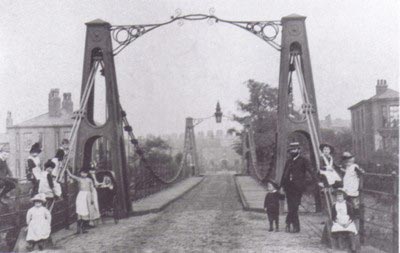
Broughton Suspension Bridge after rebuild in 1833
On April 12, 1831, the Broughton Suspension bridge collapsed, reportedly due to mechanical resonance induced by troops marching in step. But, also wind can be the cause for mechanical resonance which leads to disaster, such as for the Tacoma Narrows Bridge in 1940. But, also buildings can be affected, such as the 39-story shopping mall called the “Techno-Mart” in Seoul, Korea, that had to be evacuated because of people synchronously exercising Tae Bo.
The New Wonder of the Age
The 44 m suspension bridge was built in 1826 at the expense of John Fitzgerald, a wealthy owner of Castle Irwell House across the River Irwell between Lower Broughton and Pendleton. It is believed that all users of the bridge were required to pay a pontage to cross. Also, the bridge was of local pride since suspension bridges were considered the “new wonder of the age”.
It began as a simple military exercise
On April 12, 1831, the 60th Rifle Corps carried out an exercise on Kersal Moor under the command of Lieutenant Percy Slingsby Fitzgerald. The son of John Fitzgerald was a Member of Parliament and the brother of the poet Edward FitzGerald. When 74 men returned to barracks in Salford by way of the bridge, the soldiers, who were marching four abreast, felt it begin to vibrate in time with their footsteps. As they found the vibrations amusing some of them started to whistle a marching tune, and to humour it by the manner in which they stepped. The bridge began to vibrate more and more and when the head of the column had almost reached the Pendleton side when they heard a sound resembling an irregular discharge of firearms as it was later described. One of the iron columns supporting the suspension chains on the Broughton side of the river fell towards the bridge, carrying with it a large stone from the pier to which it had been bolted. As the corner of the bridge was no longer supported, it fell into the river. About 40 of the soldiers were thrown into the water or against the chains. Fortunately, no man was killed, but 20 were injured, some severely with broken bones and contusions to the head.
In Search for Causes
The cause of the disaster was then heavily discussed. During an investigation it was found that a bolt in one of the stay-chains had snapped at the point where it was attached to the masonry of the ground anchor. Also the bolt was probably forged and other bolts were also bent. It is believed that some time before the accident one of the cross bolts had started to bend and crack, although it is possible that they have been replaced by the time of the accident. As a conclusion, it was found that the vibration caused by marching had probably precipitated the bolt’s failure, it would have happened anyway.
Break Step whenever crossing a Bridge
After the accident, the British Army issued the order to “break step” when soldiers were crossing a bridge. However, another horrible accident occurred on April 16, 1850 in France. The Angers Bridge, also called the Basse-Chaîne Bridge, was a suspension bridge over the Maine River in Angers. The soldiers stationed in the area frequently used the bridge. On the day of the accident, two battalions of the same regiment had crossed earlier that day and the third arrived during a huge thunderstorm. The wind caused the bridge to oscillate. As the soldiers crossed the bridge, survivors reported that they had been walking as if drunk and could barely keep themselves from falling. The soldiers were, as usual when crossing the bridge, told to break step and to space themselves farther apart than normal. Still, their efforts to match the swaying and keep their balance may have caused them to involuntarily march with the same cadence. They even contributed to the resonance and the oscillation increased. The bridge was covered with more than 480 soldiers and suddenly the upstream anchoring cable on the right bank broke in its concrete mooring, three to four meters underground. Just a moment later, the downstream cable broke as well. Also, the right-bank end of the deck fell, making the deck slope very steeply and throwing soldiers into the river. 226 people died during the disaster.
Analyze and calculates loads of a suspension bridge and comparing to a cable stayed bridge, [5]
References and Further Reading:
- [1] The Philosophical Magazine and Annals of Philosophy or Annals of Chemistry, Mathematics …, Vol. IX
- [2] The Collapse of the Broughton Suspension Bridge
- [3] Angers Bridge Collapse at the World History Project
- [4] Brougthon Suspension Bridge at Wikidata
- [5] Analyze and calculates loads of a suspension bridge and comparing to a cable stayed bridge, DartmouthX – The Engineering of Structures Around Us @ youtube
- [6] Map of Suspension Bridges in the United Kingdom, via DBpedia and Wikidata






Pingback: Introduction To Mechanical Vibrations | 10 Facts About Mechanical Vibrations That Will Blow Your Mind. | BlogMech